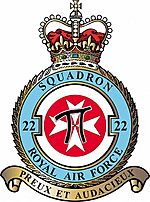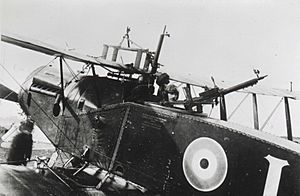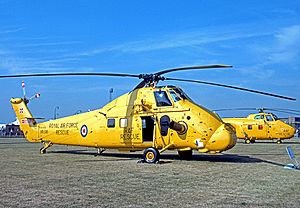No. 22 Squadron RAF facts for kids
Quick facts for kids No. 22 Squadron RAF |
|
|---|---|

No. 22 Squadron badge
|
|
| Active | 1 September 1915 – 1 April 1918 (RFC) 1 April 1918 – 31 December 1919 (RAF) 24 July 1923 – 1 May 1934 1 May 1934 – 30 September 1945 1 May 1946 – 15 August 1946 15 February 1955 – 5 October 2015 14 May 2020 – present |
| Role | Operational Evaluation Unit |
| Part of | Joint Helicopter Command |
| Garrison/HQ | RAF Benson |
| Motto(s) | Preux et audicieux (French: "Valiant and Brave") |
| Equipment |
|
| Battle honours |
|
| Commanders | |
| Officer Commanding | Wing Commander Andrew 'Keeno' Green |
| Insignia | |
| Squadron badge | On a Torteaux, a Maltese Cross throughout, overall a 'pi' fimbriated. |
| Squadron badge heraldry | Approved by King Edward VIII in May 1936. The Maltese cross denotes where the squadron was based when the badge was authorised. During this time it was based with No. 7 Squadron, having to fly over its lines away from the airfield symbolised by pi being 22 over 7. |
| Squadron codes | VR (Apr 1939 – Sep 1939) OA (Sep 1939 – Nov 1944) |
No. 22 Squadron is a special unit of the Royal Air Force (RAF). Its main job is to test and evaluate all the different types of helicopters used by the Joint Helicopter Command. This includes helicopters like the Chinook, Puma HC2, Merlin HC4, Apache, and Wildcat AH1.
The squadron also makes sure that other helicopter crews are trained by expert instructors. These instructors help crews prepare for missions around the world. No. 22 Squadron was reformed in May 2020 to take on this important role.
Before 2020, the squadron flew Sea King helicopters for search and rescue missions in the southern United Kingdom. It was first formed in 1915 as a reconnaissance unit during World War I. Later, in World War II, it became a torpedo bomber squadron. From 1955 to 2015, it was famous for its military search and rescue work across the UK.
History of No. 22 Squadron
Early Years (1915–1919)
No. 22 Squadron started on 1 September 1915 at Fort Grange, Gosport. It was formed from a group of people and equipment from another squadron, No. 13 Squadron. The squadron trained with various aircraft, like the Royal Aircraft Factory BE.2c and the Maurice Farman Shorthorn. In February 1916, they received their main aircraft, the Royal Aircraft Factory FE.2b.
On 1 April 1916, the squadron moved to France. There, they flew reconnaissance missions, which means they flew over enemy lines to gather information. During the Battle of the Somme in July 1916, they also flew fighter patrols to protect their own aircraft. They continued their reconnaissance and photography duties to support the army. A famous person, Auberon Herbert, 9th Baron Lucas, who was a politician, was wounded during an attack in November 1916 and later died.
From July 1917, the squadron began to use faster and better planes called Bristol F.2 Fighters, also known as the 'Brisfit'. By August, they had 18 of these aircraft. This helped them take part in the Battle of the Menin Road Ridge in September 1917. The squadron was very busy during the German attacks in 1918. They had to move their bases often to keep up with the changing battle lines.
In March 1919, the squadron moved to Germany as part of the British forces after the war. They returned home in August 1919. After a short time, the squadron was officially closed down on 31 December 1919.
Testing New Aircraft (1923–1934)
No. 22 Squadron was brought back on 24 July 1923. This time, its job was to test new aircraft. It worked with another squadron, No. 15 Squadron, to support the Aeroplane and Armament Experimental Establishment. For ten years, the squadron tested new planes before they were used by the military or sold to other countries. Both test squadrons were closed down on 1 May 1934.
World War II and Beyond (1934–1945)
The squadron was reformed again on 1 May 1934 at RAF Donibristle in Scotland. Its new role was as a torpedo bomber unit, flying Vickers Vildebeest biplanes. These planes could carry torpedoes to attack ships. In October 1935, the squadron was sent to Malta because of a possible war with Italy. They returned to Britain in August 1936.
In December 1936, part of the squadron formed a new unit, No. 42 Squadron. In March 1938, No. 22 Squadron moved to RAF Thorney Island. When Second World War began in September 1939, the squadron was still flying the Vildebeest. They flew patrols over the English Channel to look for enemy submarines.
From November 1939, the squadron started getting newer planes called Bristol Beauforts. These were faster, twin-engined planes. The Beaufort's engines had some problems at first, but the squadron kept flying missions with the older Vildebeest while learning to use the new aircraft. Their last mission with the Vildebeest was on 20 December 1939.
On 8 April 1940, the squadron moved to RAF North Coates. From there, they started laying mines in the sea. They flew missions over the North Sea and later from other bases. In April 1941, a pilot named F/O Kenneth Campbell was awarded the Victoria Cross for a very brave attack. He flew his plane to attack the German battleship Gneisenau in Brest harbour, causing serious damage despite heavy enemy fire. He was shot down during the attack.
In 1942, the squadron moved to North Africa and then to South East Asia. There, they changed to Bristol Beaufighter aircraft. No. 22 Squadron continued to attack enemy ships, this time using rockets. The squadron was closed down for the third time a month after the war ended.
Search and Rescue (1955–2015)
Sycamore and Whirlwind Helicopters
No. 22 Squadron was reformed in February 1955 at RAF Thorney Island. Its new and important job was Search and Rescue (SAR). They first used the Bristol Sycamore HC.12 helicopter. In June 1955, they switched to the Westland Whirlwind. The squadron performed military search and rescue missions for many years.
The squadron used Whirlwind HAR.2s until August 1962. Then, they were replaced by the Whirlwind HAR.10s. The squadron had its main base at RAF Thorney Island and operated from several other locations across the UK.
Wessex Helicopters
In June 1976, the squadron received Westland Wessex helicopters. Its main base was at RAF Finningley. The squadron had different flights (smaller groups of aircraft) based at other locations:
- 'A' Flight – RAF Chivenor, Devon
- 'B' Flight – RAF Leuchars, Fife (closed in 1993)
- 'C' Flight – RAF Valley, Anglesey
- 'D' Flight – RAF Leconfield, East Riding of Yorkshire
- 'E' Flight – RAF Manston, Kent and RAF Coltishall, Norfolk (closed in 1994)
Sea King Helicopters
In the mid-1990s, the squadron started using Westland Sea King HAR.3 and HAR.3A helicopters. The squadron's main office was at RAF Valley in Wales. They had detachments (smaller groups) of at least two aircraft at three stations to provide search and rescue cover:
- 'A' Flight – RMB Chivenor, Devon
- 'B' Flight – RAF Wattisham, Suffolk
- 'C' Flight – RAF Valley, Anglesey
- 'D' Flight - RAF Lossiemouth, Moray
Prince William, Duke of Cambridge served in the squadron as a pilot from 2010 to 2013. At the end of 2015, the squadron's search and rescue role was handed over to a civilian company, Bristow. The Sea King helicopters were then no longer used by the RAF. The last flights of the squadron closed down in October 2015.
Notable Rescues
No. 22 Squadron carried out many important rescues.
- On 11 November 1962, a fishing boat called Jeanne Gougy crashed near Land's End, Cornwall. Eight of the twenty crew members were saved by helicopter or a special rescue line. Sergeant Eric Smith received a George Medal for his brave actions.
- During the Boscastle flood of 2004 on 16 August 2004, heavy rain caused flash floods in Cornwall. Two Sea King helicopters from the squadron helped rescue about 100 people who were trapped.
Test and Evaluation (2020–Present)
No. 22 Squadron was reformed again on 14 May 2020. It is now based at RAF Benson, Oxfordshire. Its current role is to be the Operational Evaluation Unit for the Joint Helicopter Command. This means they test and evaluate new helicopters and equipment for the military.
Honours and Awards
No. 22 Squadron has received many honours for its service. These include battle honours like Cambrai 1917, Somme 1918, and France and Low Countries 1940.
Flying Officer Kenneth Campbell was given the Victoria Cross, the highest award for bravery, after he died. He carried out a daring torpedo attack on the German battleship Gneisenau in Brest harbour during World War II. Even though the weather was terrible and other planes couldn't reach the target, Campbell bravely pressed on with his attack. He badly damaged the ship but was shot down. He and his crew were buried with full military honours by the Germans.
See also
- List of Royal Air Force aircraft squadrons
- RAF Search and Rescue Force
- 202 Squadron – RAF Boulmer, RAF Lossiemouth, RAF Leconfield
- No. 1564 Flight RAF – RAF Mount Pleasant, Falkland Islands




